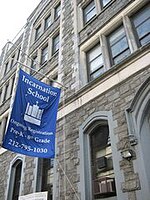178th–179th Street Tunnels
1940 establishments in New York CityExpressways in New York CityInfrastructure completed in 1940Port Authority of New York and New JerseyRoad tunnels in New York City ... and 1 more
Robert Moses projects

The 178th and 179th Street Tunnels are two disused vehicular tunnels in Upper Manhattan in New York City. Originally conceived and constructed under the auspices of Robert Moses, the twin tunnels have been superseded by the Trans-Manhattan Expressway in Washington Heights, which itself runs through a cut with high-rise apartments built over it in places. In the 1950s, the Trans-Manhattan Expressway (I-95) was constructed as a high-speed interstate bypass of the tunnels, and by 1962, the two tunnels were out of commission. Both tunnels are now are being used by the Port Authority of New York and New Jersey as storage space.
Excerpt from the Wikipedia article 178th–179th Street Tunnels (License: CC BY-SA 3.0, Authors, Images).178th–179th Street Tunnels
Trans-Manhattan Expressway, New York Manhattan
Geographical coordinates (GPS) Address Nearby Places Show on map
Geographical coordinates (GPS)
| Latitude | Longitude |
|---|---|
| N 40.845833333333 ° | E -73.931944444444 ° |
Address
Trans-Manhattan Expressway
Trans-Manhattan Expressway
10033 New York, Manhattan
New York, United States
Open on Google Maps








